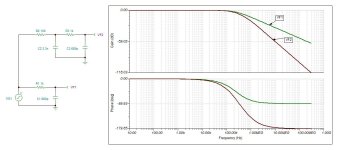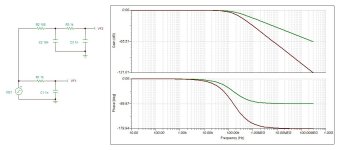I have an amplifier with several LM3886 boards I made. I knew them picking up radio might be possible, so I added a low pass filter on the positive input terminal. I have a 10uf blocking capacitor, and then a 20k input resistor. This goes to the LPF of 1k resistor plus 680pf capacitor. An online calculator says this is a 3db cutoff of around 234khz. This was noise free for the last year, but it suddenly started picking up garbled conversations of some kind. Just like once or a twice a day it'll pick up what sounds like someone talking into a tin can, sort of like that teacher from Peanuts.
Anything else I can do to harden this up a bit? Here is a rough schematic of the input and the feedback loop. I have the output recommended components and included inductor.
Thanks.
Anything else I can do to harden this up a bit? Here is a rough schematic of the input and the feedback loop. I have the output recommended components and included inductor.
Thanks.
Attachments
Shortest input and output / speaker wires as possibly. Or extra Copper shield to ground
Must have a radio operator near by, with lots of power ( possibly illegal amounts ) or poor transmitter filters.
If CB often mobile, car/truck with antenna or if AM usually church or info relay.
If short bursts, I would guess a CB with rather illegal amplifier
Must have a radio operator near by, with lots of power ( possibly illegal amounts ) or poor transmitter filters.
If CB often mobile, car/truck with antenna or if AM usually church or info relay.
If short bursts, I would guess a CB with rather illegal amplifier
Yep, increase RB1 to 2k / 2k2 to bring the 3db point down to around 100kHz. It will have minimal effect at 20kHz.

Also I assume the amp is in metal enclosure connected to GND? (think Faraday cage).
Also I assume the amp is in metal enclosure connected to GND? (think Faraday cage).
@avtech Unfortunately not really. I live in an old apartment in Spain, and apparently it's not normal to have ground rods here. The electricity is mostly considered safe since there is a dual pole residual current device that monitors the current on both paths and makes sure it's the same. IF any escapes (like through a body), it disconnects the electricity. So my house ground isn't really a ground I don't think and not much I can do about it. I measured a lot junk on whatever is on that ground, so I use a ground lift in my amp to isolate it. It all worked and sounded great until recently, but just started showing weird conversations one or twice a day through the speaker.
The largest external antenna connected to the system in most cases is the speaker wiring. Signals picked up there couple to the input through the feedback path.
Not visible on the schematic if there is any inductor in the output line. When there isn't, add one.
Not visible on the schematic if there is any inductor in the output line. When there isn't, add one.
What I was thinking likely speaker cables, dont know if ferrite bead has ever been used.
Keep lengths short as possible. As well
Not sure if using 2 pole filter for more rejection on input is common, guess it could be done.
VF2 output shown as passive 2 pole example.
Unless this is some sort of AM broadcast below 234 kHz. Could check what lowest band in your region is.
*Just checked says 530 kHz, would think 234 kHz filter would block it.
Short leads, or copper shielding, steal a ferrite bead off a old computer cable or something

Keep lengths short as possible. As well
Not sure if using 2 pole filter for more rejection on input is common, guess it could be done.
VF2 output shown as passive 2 pole example.
Unless this is some sort of AM broadcast below 234 kHz. Could check what lowest band in your region is.
*Just checked says 530 kHz, would think 234 kHz filter would block it.
Short leads, or copper shielding, steal a ferrite bead off a old computer cable or something

Last edited:
Thanks everyone! If you have any more ideas, keep 'em coming please. Sounds like so far I'll a) shorten cables b) lower that cutoff frequency of that input filter slightly.
Does that operate differently that the 1k/680p LPF I have on the +In terminal? A lot of the blog posts I read previously recommended against that and suggested the route I took (on the positive leg only) was more stable? I'm happy to do it, I just thought the consensus was it wasn't the best way going forward.
Make sure that the power pins are bypassed w 100nF ceramic caps. As close to the LM3886 chip as possible.
You might also consider using some ferrite clips on Vcc and Vee leads
You might also consider using some ferrite clips on Vcc and Vee leads
The 1K and 680pF is the low pass for incoming signal.
Regardless of what changes you make there, it will not stop RF.
What is happening with the LM3886 is both the inputs, + and - have very high impedance.
That is shown in the LM3886 schematic.

Because of that, the inputs are sensitive to RF.
I understand some users are against adding this capacitor across the +/- inputs.
Their arguments are it affects the sound quality.
Frankly, I can't hear the difference between having a 220pF and not having one.
Maybe they think they are smarter than TI and Yamaha.
Regards
Mike
AmpsLab
Regardless of what changes you make there, it will not stop RF.
What is happening with the LM3886 is both the inputs, + and - have very high impedance.
That is shown in the LM3886 schematic.
Because of that, the inputs are sensitive to RF.
I understand some users are against adding this capacitor across the +/- inputs.
Their arguments are it affects the sound quality.
Frankly, I can't hear the difference between having a 220pF and not having one.
Maybe they think they are smarter than TI and Yamaha.
Regards
Mike
AmpsLab
You've ruled out the voices in your head? 🙂 Sorry... I couldn't resist.This goes to the LPF of 1k resistor plus 680pf capacitor. An online calculator says this is a 3db cutoff of around 234khz. This was noise free for the last year, but it suddenly started picking up garbled conversations of some kind. Just like once or a twice a day it'll pick up what sounds like someone talking into a tin can, sort of like that teacher from Peanuts.
1 kΩ + 680 pF is what's recommended in the data sheet. I often go for a bit more attenuation by adding a (de-Qed) LC filter. I'd want 40+ dB of attenuation at 10 MHz. If you look at some of Siegfried Linkwitz' designs you'll see that he uses three RC filters.
Really? I've never had it pick up RF.The LM3886 is prone to picking up RF if unattended.
It looks like you have Rf2 and Cf2 fitted, so I second this suggestion.I would solder a 220pF across the + and - inputs.
It will make the LM3886 unstable, though, as the closed loop gain will be less than 20 dB.Yep, increase RB1 to 2k / 2k2 to bring the 3db point down to around 100kHz. It will have minimal effect at 20kHz.
The decoupling is in the schematic already. It looks fine to me. If anything, I would reduce the 47 uF to 22 uF, but that won't impact RF pickup. It might impact stability at heavy loads near clipping, however.Make sure that the power pins are bypassed w 100nF ceramic caps. As close to the LM3886 chip as possible.
I bet the issue is the separate grounds. They're probably joined at some star point. This sets up massive ground loops, which act as antennae for RF pickup. Connect all three grounds together with a low inductance connection, ideally a PCB plane, and connect them to the centre of the local decoupling, i.e., the 22-47 uF decoupling caps.
Tom
Huge ground loop is , hmmm, a good dipole antenna , if you say (post #5) that your home wiring is not grounded, some accidental ground loop could make it easily. To start I would connect all power cables to one extension power cord and see what happens.
@ tomchr
Really? I've never had it pick up RF.
Maybe you're not in a zone where RF is an issue.
I had this RF intrusion about 15 yrs ago.
I was testing out an Altec 9444B amplifier in my lab and I was horrified to hear music coming from a radio station down the road.
In the mid 90s, I was present in an important meeting when a cabinet minister was coming.
Before his arrival, music was suddenly coming out in their pa system.
Apparently, someone one floor below happened to switch on the radio.
My client's face turned pale. She immediately when down and told them to switch it off.
No music was heard throughout the meeting.
She was using one of those cheap mixers.
My guess is the mic input was unbalanced.
Mike
Really? I've never had it pick up RF.
Maybe you're not in a zone where RF is an issue.
I had this RF intrusion about 15 yrs ago.
I was testing out an Altec 9444B amplifier in my lab and I was horrified to hear music coming from a radio station down the road.
In the mid 90s, I was present in an important meeting when a cabinet minister was coming.
Before his arrival, music was suddenly coming out in their pa system.
Apparently, someone one floor below happened to switch on the radio.
My client's face turned pale. She immediately when down and told them to switch it off.
No music was heard throughout the meeting.
She was using one of those cheap mixers.
My guess is the mic input was unbalanced.
Mike
The ESR of the electrolytics render them useless at RF. Analog Devices and TI have several apnotes on the topic
Ground plane yes, otherwise the leads to ground are just antennae.
Ground plane yes, otherwise the leads to ground are just antennae.
I second Tom's remarks about star grounds. Star grounds work fine at 50 Hz and at 60 Hz, but are a disaster at higher frequencies. I also think experimenting with clip-on ferrites around the input and output cables is a good idea.
Besides, the first-order series filters recommended by Thiele are supposed to protect better against RF picked up by the loudspeaker leads than the usual output circuits. See https://www.diyaudio.com/community/...output-stability-networks.423666/post-7923965 and https://www.diyaudio.com/community/attachments/7386-pdf.741268/
Besides, the first-order series filters recommended by Thiele are supposed to protect better against RF picked up by the loudspeaker leads than the usual output circuits. See https://www.diyaudio.com/community/...output-stability-networks.423666/post-7923965 and https://www.diyaudio.com/community/attachments/7386-pdf.741268/
- Home
- Amplifiers
- Chip Amps
- LM3886 Diy PCB starting picking up CB or conversations?

